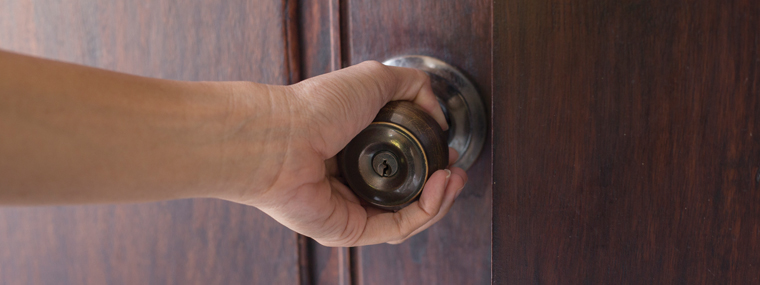
Who Has the Right to Enter Your Unit?
By Ryan D. Poliakoff / Published August 2019

Q
uestion:
Does our association have the legal right to enter our unit to remove our main entrance door and take it away for exterior laminating? The association would have to forcefully enter our unit to remove the doors, as the hinges are inside the apartment. This laminating would alter the appearance of our doors and constitute a “material alteration or substantial addition,” which means to “palpably or perceptively vary or change the form, shape, elements, or specifications…from its original design or plan, or existing condition, in such a manner as to appreciably affect or influence its function, use, or appearance.” The plan would also include changing our lock system hardware.
Answer:
Your question raises a number of interrelated issues. I am going to assume that you live in a condominium, as I can’t imagine many situations where an HOA would be responsible to maintain an owner’s front door. (It may happen in townhome communities, but it wouldn’t be particularly common in communities with single family homes.)
The first question is, who owns your door? Is the door a common element of the association? Or, is it part of your unit? If you look in your declaration of condominium, you will find a provision describing the unit boundaries. You should check to see whether those boundaries include perimeter apertures and whether doors are expressly discussed. I have seen condominiums where entrance doors are common elements, and I have seen declarations that define the doors as part of the unit. It could go either way.
That determination does not end the analysis. The second question is, who has the responsibility to maintain the doors? Even if the door is part of your unit, it may be that the association is responsible for its maintenance and repair. Or, conversely, it’s conceivable that a common element door would have to be maintained by the unit owner. You will find a different section of your declaration that describes the maintenance responsibilities of the association and the unit owners. It may broadly state that the association maintains common elements, or it may separate out individual items to be maintained by different parties, regardless of whether they constitute common elements or unit owner property.
Let’s assume that you’ve evaluated the declaration, the door is your property, and you are responsible for maintaining the door. In that situation, I think the association would have difficulty justifying the forcible maintenance of the door on your behalf. The cost of such maintenance might not constitute a proper common expense, and it would be unusual for a condominium declaration to expressly give the association the power to exercise “self-help” in the event that you are failing to maintain your own door.
But, I suspect it’s more likely that the door is a common element, and/or the association is responsible for its maintenance. If that’s the case, the next question is, does the association have the right to enter your unit? In fact, it does. The Condominium Act provides that the association has the irrevocable right to enter any unit during reasonable hours to maintain or prevent damage to the property. If the door is association property, and if you have an obligation to allow the association to enter your unit to maintain that property, the association could arguably enter your unit (using a locksmith to open the door if needed), remove the door, and perform the required maintenance. However, there are practical considerations that weigh against that strat-egy. First, as a matter of basic safety, people have guns, and it’s unwise to forcibly enter someone’s home even when the law provides you with such right. Second, judges tend to frown upon self-help, in general—the proper procedure would be for the association to obtain an order from an arbitrator or judge. You should be aware that, if you force the association to sue you, if and when you lose the lawsuit, you will be responsible for the association’s attorney’s fees, which can be extensive. If the association is responsible to maintain the doors, it probably is not worth the fight to prevent them from doing so.
Your last question is, does the lamination of the doors constitute an improper material alteration, requiring a membership vote? The Condominium Act provides that material alterations to the common elements must be approved by 75 percent of the membership (or whatever percentage is stated in the declaration). You state that the lamination would change the appearance of your door. The question, really, is how much. Simply making your painted blue door into a laminated blue door, or changing it from a semi-gloss door to a glossy door, might not be enough of a change to be considered “material.” But, changing the color of the doors probably would be material. You should consider, however, that arbitrators recognize an exception to the material alteration rule when the purpose of the change is not for the primary purpose of altering its appearance, but instead is in furtherance of the association’s maintenance obligation. For example, let’s assume that you have painted wood doors, and that they are easily scratched and dented. And, let’s further assume that, by laminating the doors, the association is greatly reducing the long-term cost of maintenance. That could very well be a sufficient argument to be granted an exception by an arbitrator.
Overall, assuming that the association is in fact responsible to maintain your doors, and if the lamination of the doors constitutes a minor change to their appearance (or if there is an obvious maintenance purpose for doing so), I would think your chances of surviving a legal challenge are low.
Ryan D. Poliakoff
Partner, Backer Aboud Poliakoff & Foelster
Ryan D. Poliakoff is a partner of Backer Aboud Poliakoff & Foelster and serves as general counsel to condominiums, homeowners associations, and country clubs throughout South Florida. He is the co-author of New Neighborhoods —The Consumer’s Guide to Condominium, Co-Op, and HOA Living. In addition to representing associations, he is a frequent contributor at seminars and workshops for attorneys and board members, and he has written hundreds of articles for magazines and newspapers throughout the United States. He can be reached at rpoliakoff@bapflaw.com. For more information about his firm, visit www.bapflaw.com.




